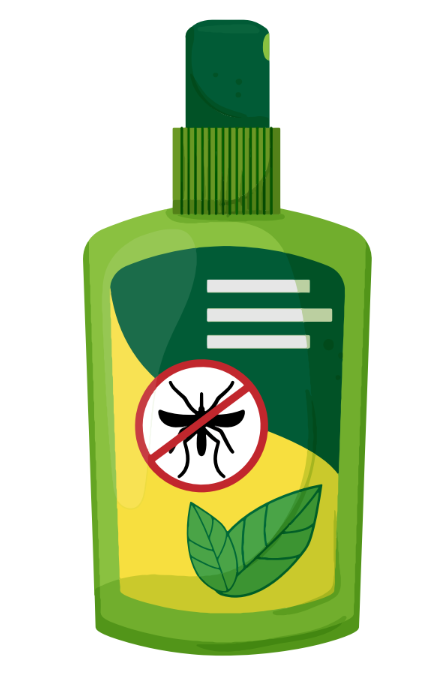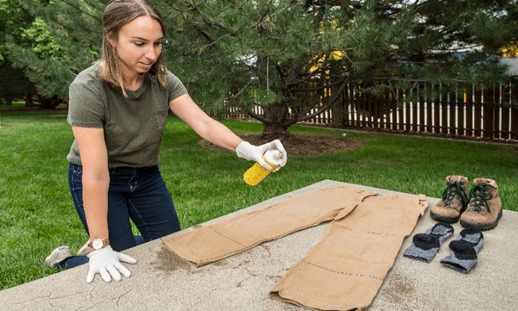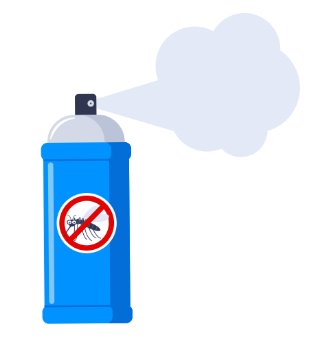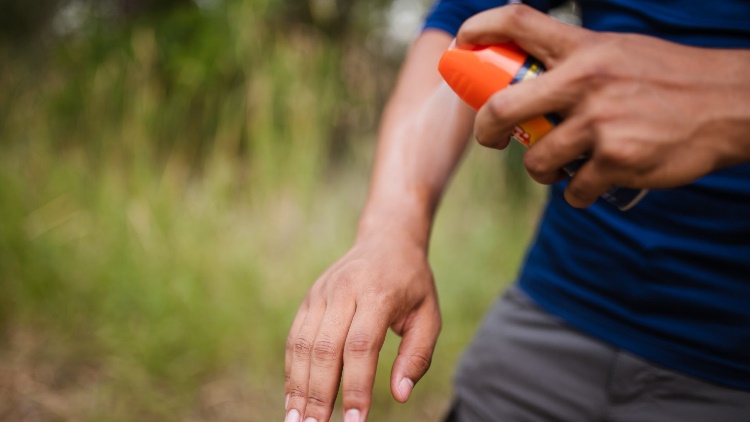To best avoid mosquito and tick bites, cover up with long sleeved clothing and use an EPA registered insect repellent. Follow the directions on the package label. Only apply to exposed skin and clothing, if directed. Do not apply to skin under clothing.
DEET
One of the oldest, most effective, and most researched insect repellents available. 10%-30% concentration recommended, higher concentrations last longer. The American Academy of Pediatrics recommends that DEET repellents up to 30% concentration are safe to use on children, older than two months, when following the label. Do not use repellents on children two months or younger. DEET has been shown to reduce SPF of sunscreens by up to 1/3. If using with DEET, sunscreen may need to be applied more frequently. Can damage some plastics and synthetic fibers. Once back indoors, wash treated skin with soap and water. Wash clothing before wearing it again. May cause eye irritation.
Picaridin
Registered in the USA in 2005, Picaridin is a synthetic version of a repellent found in pepper plants. 10%-20% concentrations most effective. Odorless, non-irritating, and does not harm plastics or synthetic fibers. 20% concentrations can last 8-12 hours. When applied correctly, Picaridin forms a vapor barrier at the skin surface that deters mosquitoes from landing on the skin. After returning indoors, wash treated skin with soap and water. May cause eye irritation. Do not use repellents on children two months or younger.
IR3535
Developed by Merck in the 1980s, it was first registered with the EPA in 1999 as a biopesticide. Its chemical name is Ethyl butylacetylaminopropionate and it is a synthetic version of a naturally occurring amino acid. It is colorless, odorless, and biodegradable. Available as a spray, wipe, and lotion in 10%-20% concentrations. Very effective against biting flies, biting midges, ticks, and most mosquito species including Culex species that can spread West Nile Virus and Aedes species that can spread Zika, Dengue, Chikungunya, and Yellow Fever. Not as effective against Anopheles species that can spread Malaria, so it is not recommended to be used when traveling to areas with endemic Malaria. May damage some plastics and synthetic fibers. May cause moderate eye irritation. Can be used on children older than 6 months.
Oil of Lemon Eucalyptus/para-menthane-3,8-diol (PMD)
Oil of Lemon Eucalyptus (OLE), not to be confused with Lemon Eucalyptus Oil which is just a botanical product, is an EPA registered insect repellent that has been tested for safety and efficacy. It is derived from the leaves of the Corymbia citriodora of the eucalyptus family and refined to increase the levels of para-menthane-3,8-diol (PMD), the aromatic terpenoid that works to repel biting insects. Refined OLE contains around 70% PMD. Pure PMD products are available but do not show as much insect repellency as OLE. OLE may cause irritation or allergic reactions for those with sensitive skin. It can cause significant eye damage, flush eyes immediately for 15 minutes if exposed. Not for use in children under 3 years. May be less effective than other repellents against Aedes aegypti mosquitoes, avoid using in areas where mosquito diseases are endemic and aegypti are present.
Permethrin
Permethrin is an insecticide in the pyrethroid family. Pyrethroids are synthetic chemicals that act like natural extracts from the chrysanthemum flower and act on an insect’s nervous system. First registered in the US in 1979 and re-registered in 2006, it has a long history of use and study. It has many uses and formulations including in certain flea and tick collars for pets, in a medicated cream for human lice or scabies, or for treating clothing as an insect repellent. In other parts of the world, mosquito bed nets are treated with Permethrin. Trusted by industry and professionals, Permethrin is applied directly to clothing exteriors. Once applied, it can withstand multiple washes while remaining effective, but should be washed separately. Apply outdoors in a well-ventilated area with eye protection and gloves. Hang to dry completely before adorning. Very effective against ticks. Professionally treated clothing is available to purchase online that greatly increases the effective time-duration of the treatment. Always read and follow the label for detailed instructions and length of effective treatment. Permethrin-treated clothing can be more convenient compared to skin-applied repellents since it does not need to be applied directly to your skin. Use of permethrin-embedded clothing is useful in areas infested with mosquitos and ticks with high disease risks, and where other repellents are less effective. Not for use on children’s clothing before 2 months.
Check out the EPA’s Insect Repellent Search Tool to find specific brands and formulations of repellents.

 Person applying permethrin directly to clothing, as stated on the label.
Person applying permethrin directly to clothing, as stated on the label.

 Check the label, most repellants are meant to be applied directly to skin.
Check the label, most repellants are meant to be applied directly to skin.